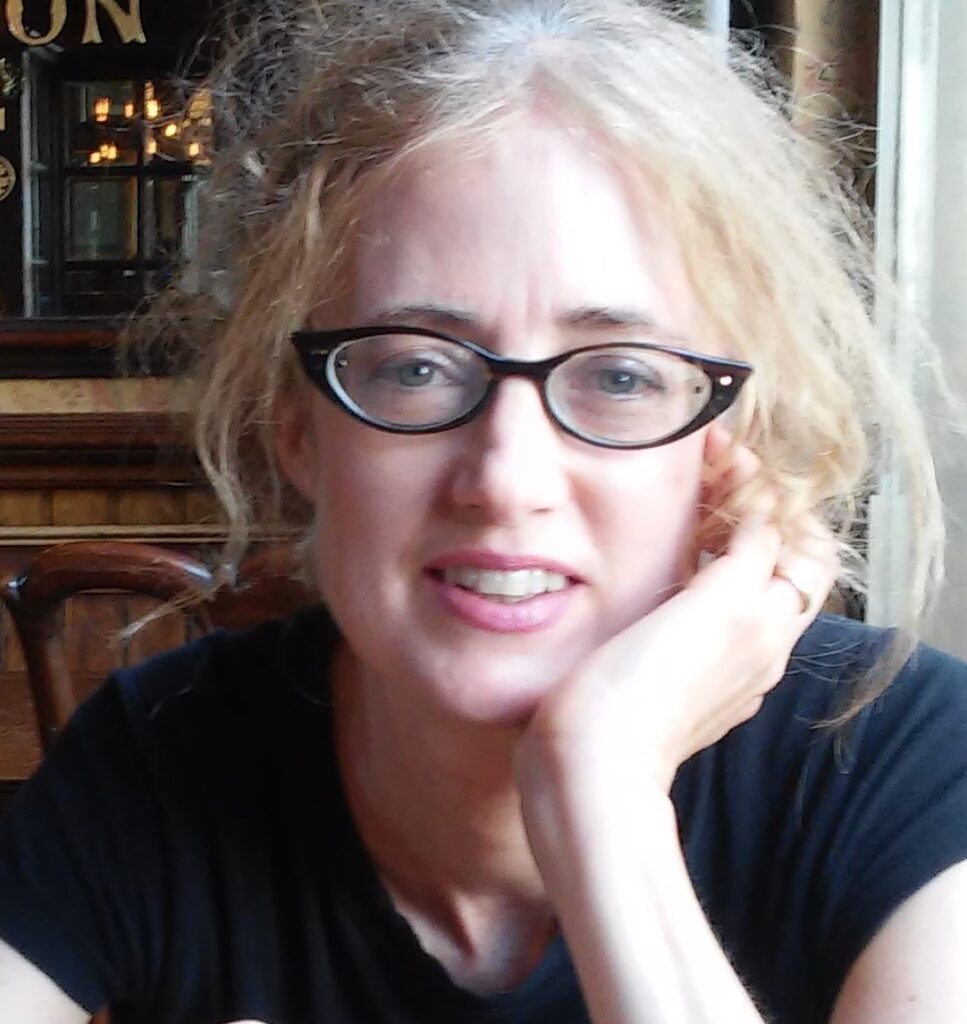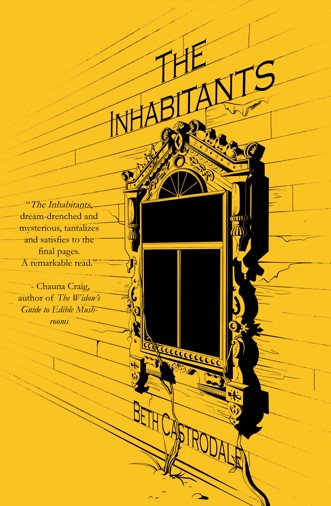Have you ever been in a building that just made you feel uncomfortable? You know you don’t like being there, but it’s hard to specify why? Maybe it’s a movement in the corner of your eye that makes you feel like you’re being watched. Or perhaps it’s the maze of corridors and identical doors that makes you feel trapped. Today, we speak with author Beth Castrodale about the ways the very architecture of houses can make you feel either comfortable, or haunted. Also, which styles of buildings are more likely to be haunted. Do you live someplace that’s prone to supernatural activity? Find out today, on Homespun Haints.
Listen now:
Or watch the episode on YouTube:
About the Guest: Beth Castrodale

The way she describes her books makes our goth hearts soar. We want to read every one of them right now. Her first novel was about a scandal-fleeing corset maker during the Depression Era (Marion Hatley). The second book is about a former indie rock star turned gravedigger, overcoming his guilt-ridden past (In This Ground). Her third is about sisters reconnecting over their criminal father’s unfinished business (I Mean You No Harm).
Beth’s most recent novel as of this writing is now available for pre-order through Regal House Publishing. The Inhabitants is coming out September 10, 2024. Keep up with all of Beth’s happenings at her website, BethCastrodale.com, or ask her a question on Goodreads. You can also follow her on Facebook and X.

Beth’s Ghost Story
Beth tells us real haunted apartment stories that may have, in part, inspired her fascination with ghost stories. She used to live by the ocean in a little attached apartment. She’d occasionally come home to some very confusing circumstances, even though she always locked her doors and windows before leaving. That’s when she found out that a friend of her landlord’s had died in that apartment. Was there a connection? There’s never been any other forthcoming explanation for the strange happenings she witnessed in that haunted apartment.
What are the architectural features of a haunted house?
Victorian and gothic architecture was, in many cases, specifically designed to soothe the mind and rejuvenate the soul. And then, there are those houses that feel like they must be haunted, just by the way they look. Beth tells us that, at least in novels, the architecture of any haunted house will likely share some specific features. Here are some of the features an evil architect might incorporate into a hauntingly scary house.
- Being difficult to exit, or making inhabitants feel trapped or lost within.
- Liminal spaces like staircases without a clear view of the space beyond.
- Never having quite enough light, or seeming to absorb what little light enters.
- Situations where one might find themselves in absolute darkness, or complete silence.
- Low ceilings.
- Closed-in, claustrophobic spaces.
The psychology of haunted house architecture
These similarities in architecture among haunted houses probably exist for a reason. All of these features have a potential to evoke disturbing emotions, which can make inhabitants feel uneasy. Take absolute silence, for example. There are very few places in life where people with hearing actually experience REAL silence. When the house seems silent to our conscious mind, there are likely sounds still happening that fall outside the audible range. More than one study has found that infrasound at around 19 Hz could cause physical effects in humans. Not just any physical effects, but specifically feelings of anxiety, shivering, and chest pressure, all of which could likely contribute to the perception of a paranormal event.
In addition, the effect of low ceilings might be inferred by examining the inverse. Turns out, there’s actually a name for the feeling of awe and spiritual elevation one feels when inside a large, high-ceilinged indoor venue: the “Cathedral Effect.” Research indicates that high ceilings can actually create a sense of openness and freedom, which can lead to abstract and creative thinking. This is one reason why places of worship usually feature high ceilings.
Why is Gothic Revival architecture associated with haunted houses?
In this interview, Beth tells us that, in Gothic novels, the house itself is a character. Often, the house has agency, a backstory, even a fate. In stories like “The Fall of the House of Usher” by Edgar Allan Poe, or “Wuthering Heights” by Emily Brontë, the house reflects (and perhaps influences) the mental state of the characters. In some cases, like in “The Haunting of Hill House” by Shirley Jackson and “The Woman in Black” by Susan Hill, the house even directly controls or influences the characters, driving the plot. Many Gothic novels exemplify this association between Gothic architecture, haunted houses, and ghost stories, but is it strictly a literary convention, or something more insidious?
Houses in Dreams
Interestingly, in at least one style of dream interpretation, houses and similar environments represent the mindset of the dreamer. Because dreams are the language of the subconscious in a sense, this quantum entanglement of sorts between one’s house and one’s mindset seems programmed deep in our human psyche. Yet, dreams are sort of ghost stories in their own right, are they not? Fictional alternate worlds where the rules of reality don’t apply, featuring people who may not precisely exist, whose main purpose is to represent an idea?
What mindset do OUR houses represent?
Diana’s house is streamlined and spartan. Most of the things she furnishes and decorates it with were found objects, hand-me-downs, or handmade crafts. She prefers to have a designated place for everything to hide away when not in use. The few exceptions to this frugal minimalism are a handful of mementos with little intrinsic value besides the people, places, and experiences they abstractly remind her of. Even though the aesthetic of the home hints at the deep well of darkness below the surface, Diana values having a home full of natural light, which filters into rainbows through translucent prisms of privacy film on the windows.
The only landscaping Diana cultivates is either fast-growing vines, or easily-moved potted plants. Diana has never lived in a home long enough for larger, slower plants like trees and shrubs to germinate and mature. Amazon Music is often playing on shuffle, or there’s dead silence; there’s never a TV on in the background.
What things about Diana does her home reflect?
Similar to her house, Diana’s mindset values light, in the form of enlightenment and education. Her aesthetics are more of a game than a standard: whereas she might wear a ballgown to a casual dinner, most days she wears only pajamas. She values privacy, and lets very few people in. And like her house, she’s much nicer inside than her rough exterior would imply. Like her plants, Diana doesn’t enjoy putting down roots, preferring to be trans-locational when possible. She’s quiet and introspective for the most part, and like her music, has a habit of just going with the flow instead of making distinct choices and following them to fruition.
Becky’s house reflects her nature.
Becky’s house is more open, with very high ceilings and quite a bit of natural light, coming through clear, floor-to-ceiling windows that offer no privacy, which is fine because it’s set far back from the street in a small copse of old trees. All the entrances are convoluted, especially the front door, making it a little daunting to enter the house for the first time.
Inside, her belongings are out and about, wherever she likes to use them. Every wall shines with professionally curated art and family portraits. There’s usually a record spinning on the turntable, and the delectable smell of things frying in butter wafting out of the warn, roomy kitchen. There’s always a whirlwind of activity inside, as several 2- and 4-legged children romp within. She’s also recently discovered a surprise, hidden behind a wall for the past 40 years, which you’ll hear about in this episode.
What parts of Becky’s personality does her home reflect?
Like her house, Becky is an open book. Yet, she’s one so far off the beaten path that not everyone attempts to read her. She has a penchant for catching people off-guard with non-sequiturs, which feels like she’s revealing secret passageways between parts of her own mind. Like Diana, she also values education. She tends towards pursuing the A in STEAM more than the other letters. Her wide open spaces full of useful and whimsical belongings lend themselves to creative expression and flow states. Like her established arbor, Becky is settled and doesn’t mind having some roots, even feeling like her current city offers her opportunities for growth. Also, like the constant movement in her house, she tends to mainly pass through her home as part of a wider, global orbit. She’s always planning the next trip out of town before the previous trip even starts.
Based on the architecture, is your house haunted?
Hainted Loves, what do you think? Does architecture influence hauntings? Are some buildings just irresistible to wandering spirits? Have you lived in a haunted house with any of these architectural features? If you have a true ghost story about haunted houses, why not submit it to tell on Homespun Haints? We’d love to have a spooky day with you!
